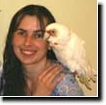Why I Weigh & Measure Eggs
Kristen Reeves, Meadowlark Farms Avian Supply, Inc.

Measurements for a current clutch of Society eggs laid by a young first-season hen
LEGEND:
First column = (2) clutch number for season, (15) year, (2) total clutches over hen's breeding life TO DATE. Older hens may have a number as such: 2.15.18 - see the last number? That represents ALL clutches over the breeding lifetime of that particular hen.
Second column = Date egg was laid
Third column = Egg length in millimeters
Fourth column = Egg weight in grams
Fifth column (currently empty) = hatch date
Last column = expected hatch date
In my aviary the breeding season begins for all Australian species and Societies in the Fall. The season typically runs until Mid to late March and occasionally early April depending on how long it takes for each clutch to fledge and wean. That means that parts of a "season" for each hen may be split up between 2014 and 2015 (example).
The "season" column indicates ALL clutches laid in a single calendar year including remnants from the end part of the previous Fall breeding season and the beginning parts of a new Fall breeding season resulting, in most cases, in a total of 6 clutches per "Season".
When I see "3" in that first column, it tells me the hen should not be bred again until the next Fall season. If she lays 3 clutches before the end of the year and a "6" is entered in that column, she will not be bred again until the NEXT Fall season - regardless of time in between. That's my self-imposed restriction to keep my hens healthy.
I consider ANY clutch laid - regardless of hatch status - to be a clutch and it's entered as such in that record. Once she hits a 6, she's not bred until the NEXT Fall season.
In addition, my hens are never allowed more than 3 clutches per season and are often pulled down after 2 or even 1 clutch if I see something I don't like. That could be ratty or messy feathers, messy droppings, missing feathers, an overly amorous or aggressive mate, or unusually large or small eggs that may mean calcium processing issues. Sometimes I pull them down because I'M done, not necessarily for any other reason! Breeding season is a lot of work!
To each his own, but in MY aviary I'm about QUALITY...NOT QUANTITY!!! I will not sacrifice the health or quality of my birds for any reason! This careful husbandry leads to healthier adults, rare illness in the aviary, and more robust chicks - even if it means fewer of them per season! ~k
After posting that and photo, I received an EXCELLENT question as follows:
Hello Kristen, i understand that you collect a lot of information per clutch per pair. A lot of work especially for measuring the length and the weight of the eggs. How you use these infos as statistical figures (length and weight)? Is this information gathered in all previous breeding seasons useful for the new coming one?
Below is my response -
I use every bit of data I collect to decide which birds to breed, which should be retired, how to pair breeders, whether the nutrition needs to be reevaluated, etc. I also use age and a multitude of other factors.
Most eggs in my aviary fall within a specific range. 18.5-19.5mm (Gouldians), while Societies and other species have very different ranges - some larger, some smaller. But regardless of species, smaller than average eggs or weights often mean the parents are not getting "something" nutritional they need or possibly have some kind of disease process going on. Breeding hormones lower the immune system, opening the birds up to a host of potential issues.
When I see small eggs, I watch closely to see exactly what seeds and supplements they are eating (literally count seed hulls, weigh & measure mineral content, drinker content, etc.) and tweak their mixes, I test droppings, run cultures, and take the parents in hand for another overall health check. If I find nothing wrong, I just keep observing. Every bird in the aviary is evaluated for overall health BEFORE being paired, so when changes occur or averages fall below or above normal, I must take action.
Overly large eggs can be nutritional as well so the same (above) applies. But because I try to pair in the hopes of producing birds more likely to appeal to the judges, I pair larger birds with smaller ones to put some size on the chicks. I have to keep a close eye on them.
Like breeding a Chihuahua to a Great Dane - if the female (Chihuahua) is too small or male (Great Dane) is too large, she won't be able to safely birth the pups which can end up destroying her. Of course that is a bit of an exaggeration, but I'm trying to give an example of why I track this information! In the birds, sometimes eggs can be overly large and not pass easily from a smaller hen resulting in egg binding, torn cloaca, or a horribly exhausted hen. If I see this, I pull the pair and review my pairing to see where I went wrong. The hen is released to the resting flight to recover and not paired until the following season. The cock may be used in another pairing if I still have hens to be paired. These new pairings aren't always successful after a pair has bonded, so good initial pairing is crucial.
There is a very fine line I won't cross when pairing. A lot of it is instinct, but I use my records in my overall choice for breeding pairs!
Every bird bred here has their own records, so I compare not only the hen's birth records, but her clutch results to the birth records of the cock bird. If he hatched from an overly large egg, chances are any hen he is paired with will end up producing overly large eggs. It's not an exact science - nutrition and overall health also play a crucial role - but it has worked well for me over the years.
Yes, I suppose it IS a lot of work! But it has become a normal part of my routine. I NEED to know what makes these birds tick, so I do what it takes - and I see correlations regularly! I don't even think about "why" I do it anymore - I know, and have found it exceptionally useful - so I just do it! ~k





